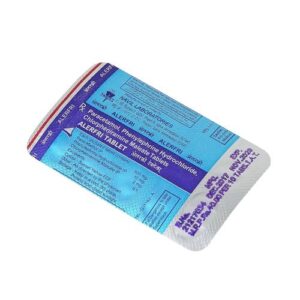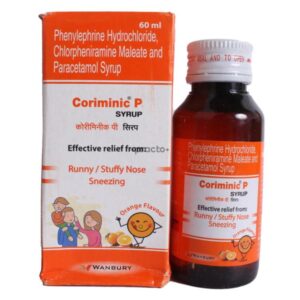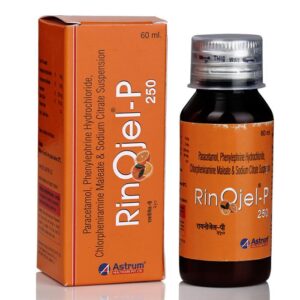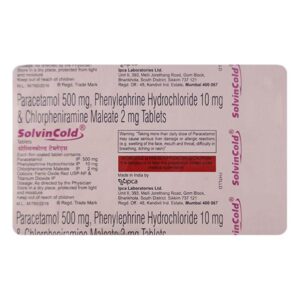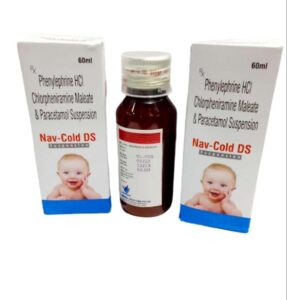CHLORPHENIRAMINE + PARACETAMOL (ACETAMENOPHEN) + PHENYLEPHRINE
Chlorpheniramine: Chlorpheniramine is an antihistamine drug used to relieve symptoms associated with allergies, such as sneezing, itching, watery eyes, and runny nose. It can also be used to treat symptoms of the common cold, such as cough and congestion.
The mechanism of action of Chlorpheniramine involves blocking the effects of histamine, a substance released by the body during an allergic reaction. By doing so, it helps to reduce or prevent the symptoms caused by histamine, providing relief to the patient.
The recommended dose of Chlorpheniramine varies depending on the age and condition being treated. For adults and children over 12 years old, the usual oral dose is 4 mg every 4 to 6 hours, not exceeding 24 mg in a 24-hour period. For children aged 6 to 12 years, the dose can range from 2 to 4 mg every 4 to 6 hours, not exceeding 16 mg in a 24-hour period. It is important to follow the dosage instructions provided by a healthcare professional or the product label.
Like any medication, Chlorpheniramine may cause side effects. Common side effects include drowsiness, dizziness, dry mouth, blurred vision, and constipation. These side effects are generally mild and temporary. However, some individuals may experience more serious side effects like difficulty urinating, rapid heartbeat, confusion, or hallucinations. If any severe or persistent side effects occur, it is essential to seek medical attention promptly.
Chlorpheniramine may interact with other medications, including central nervous system depressants like alcohol or sedatives, so it is important to inform a healthcare professional about any other medications being taken.
As with any drug, it is important to consult with a healthcare professional before starting Chlorpheniramine to ensure its suitability and to receive personalized dosage instructions and monitoring.
Paracetamol (acetamenophen): Paracetamol, also known as acetaminophen, is a common over-the-counter medication used to relieve pain and reduce fever. It is classified as an analgesic (pain reliever) and antipyretic (fever reducer).
Paracetamol works by blocking the production of certain chemicals in the body that are responsible for pain and fever. It primarily acts on the central nervous system and inhibits the activity of cyclooxygenase enzymes, which are involved in the production of prostaglandins, substances that contribute to pain and fever.
The recommended dose of paracetamol for adults is generally 325-650 mg every 4-6 hours, not exceeding a maximum daily dose of 4 grams (4000 mg). However, it is essential to follow the specific instructions provided by the healthcare provider or stated on the packaging.
As for side effects, paracetamol is generally considered safe when used correctly. However, exceeding the recommended dosage can cause liver damage, especially in cases of overdose. Other potential side effects include skin rashes, difficulty breathing, swelling of the face, lips, tongue, or throat (indicative of an allergic reaction), and blood disorders in rare cases.
It is crucial to be cautious when using paracetamol, especially for individuals with liver problems, those who consume alcohol regularly, or those taking other medications that may interact negatively with paracetamol. It is always advisable to consult a healthcare professional before using any medication to ensure its safety and appropriateness for individual circumstances.
Phenylephrine: Phenylephrine is a medication that is commonly used as a decongestant to relieve nasal congestion caused by allergies, colds, or sinus infections. It works by narrowing the blood vessels in the nasal passages, reducing swelling and congestion.
Phenylephrine belongs to a class of drugs called sympathomimetic amines, which stimulate the sympathetic nervous system. It acts as an alpha-1 receptor agonist, specifically targeting alpha-1 adrenergic receptors on the smooth muscle lining the blood vessels in the nasal passages. By binding to these receptors, it causes constriction of the blood vessels and decreases the production of mucus, resulting in relief from nasal congestion.
This medication is available in various forms, including oral tablets, nasal sprays, and eye drops. The appropriate dose and frequency of use depend on the specific formulation and the individual’s age and medical condition. It is important to follow the instructions provided by the healthcare professional or follow the directions on the product label.
While generally safe when used as directed, Phenylephrine may cause certain side effects. Common side effects include nervousness, restlessness, headache, nausea, dizziness, and increased blood pressure. It is important to note that Phenylephrine should be used with caution in individuals with heart disease, high blood pressure, diabetes, or thyroid problems, as it can worsen these conditions.
In some cases, Phenylephrine may cause severe side effects that require immediate medical attention. These can include difficulty breathing, chest pain, rapid heartbeat, severe headache, or swelling of the face, tongue, or throat.
As with any medication, it is recommended to consult with a healthcare professional before using Phenylephrine to determine if it is suitable for your specific condition and to discuss any potential drug interactions or contraindications.

